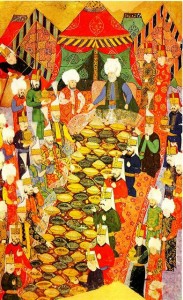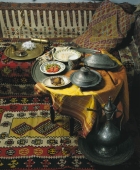SULTAN?S KITCHEN
 Culinary attitudes towards meat, dairy products, vegetables and grains that characterized this early period still make up the core of Turkish thinking. Early Turks cultivated wheat and used it liberally in several types of leavened and unleavened bread either baked in clay ovens, fried on a griddle, or buried in embers. ?Manti? (dumpling). and ?bugra,? (the ancestor of ?borek,? or filled pastries, named for Bugra Khan of Turkestan) were already among the much-coveted dishes of this time. Stuffing not only the pastry but also all kinds of vegetables was common practice, and still is, as evidenced by dozens of different types of ?dolma?. Skewering meat as well as other ways of grilling, later known to us as varieties of ?kebab,? and dairy products, such as cheeses and yogurt, were convenient staples of the pastoral Turks. They introduced these attitudes and practices to Anatolia in the 11th century In return they met rice, the fruits and vegetables native to the region, and hundreds of varieties of fish in the three seas surrounding the Anatolian Peninsula. These new and wonderful ingredients were assimilated into the basic cuisine in the millennium that followed.
Culinary attitudes towards meat, dairy products, vegetables and grains that characterized this early period still make up the core of Turkish thinking. Early Turks cultivated wheat and used it liberally in several types of leavened and unleavened bread either baked in clay ovens, fried on a griddle, or buried in embers. ?Manti? (dumpling). and ?bugra,? (the ancestor of ?borek,? or filled pastries, named for Bugra Khan of Turkestan) were already among the much-coveted dishes of this time. Stuffing not only the pastry but also all kinds of vegetables was common practice, and still is, as evidenced by dozens of different types of ?dolma?. Skewering meat as well as other ways of grilling, later known to us as varieties of ?kebab,? and dairy products, such as cheeses and yogurt, were convenient staples of the pastoral Turks. They introduced these attitudes and practices to Anatolia in the 11th century In return they met rice, the fruits and vegetables native to the region, and hundreds of varieties of fish in the three seas surrounding the Anatolian Peninsula. These new and wonderful ingredients were assimilated into the basic cuisine in the millennium that followed.
Anatolia is the region known as the ?bread basket of the world.? Turkey, even now, is one of the seven countries in the world, which produces enough food to feed its own populace, and still has plenty to export. The Turkish landscape encompasses such a wide variety of geographic zones, that for every two to four hours of driving, you will find yourself in a different zone amid all the accompanying changes in scenery temperature, altitude, humidity, vegetation and weather. The Turkish landscape has the combined characteristics of the three oldest continents of the world (Europe. Africa, and Asia) and an ecological diversity surpassing any other country along the 40th latitude. Thus, the diversity of the cuisine has taken on that of the landscape with its regional variations.
In the eastern region, you will encounter rugged, snow-capped mountains where the winters are long and cold, along with the highlands where the spring season with its rich wild flowers and rushing creeks extends into the long and cool summer. Livestock farming is prevalent. Butter, yogurt, cheese, honey meat and cereals are the local food. Long winters are best endured with the help of yogurt soup and meatballs flavored with aromatic herbs found in the mountains, followed by endless servings of tea.
The heartland is dry steppe with rolling hills, and endless stretches of wheat fields and barren bedrock that take on the most incredible shades of gold, violet, and cool and warm grays, as the sun travels the sky Along the trade mutes were ancient cities with lush cultivated orchards and gardens. Among these, Konya, the capital of the Seljuk Empire (the first Turkish State in Anatolia), distinguished itself as the center of a culture that attracted scholars, mystics, and poets from all over the world during the 13th century. The lavish cuisine that is enjoyed in Konya today; with its clay-oven (tandir) kebabs, boreks. meat and vegetable dishes and helva desserts, dates back to the feasts given by Sultan Alaaddin Keykubad in 1237 AD.
Towards the west, one eventually reaches warm, fertile valleys between cultivated mountainsides, and the lace-like shores of the Aegean where nature is friendly and life has always been easy-going. Fruits and vegetables of all kinds are abundant, including, best of all, seafood! Here, olive oil becomes a staple and is used both in hot and cold dishes.
The temperate zone of the Black Sea Coast, to the north, is protected by the high Caucasian Mountains and abounds in hazelnuts, corn and tea. The Black Sea people are fishermen and identify themselves with their ecological companion, the shimmering ?hamsi? a small fish similar to the anchovy. There are at least forty different dishes made with hamsi, including desserts! Many poems, anecdotes and folk dances are inspired by this delicious fish.
 The southeastern part of Turkey is hot and desert-like offering the greatest variety of kebabs and sweet pastries. Dishes here are spicier compared to all other regions, possibly to retard spoilage in hot weather, or as the natives say to equalize the heat inside the body to that outside!
The southeastern part of Turkey is hot and desert-like offering the greatest variety of kebabs and sweet pastries. Dishes here are spicier compared to all other regions, possibly to retard spoilage in hot weather, or as the natives say to equalize the heat inside the body to that outside!
The culinary center of the country is the Marmara Region, including Thrace, with Istanbul as its Queen City. This temperate, fertile region boasts a wide variety of fruits and vegetables, as well as the most delicately flavored lamb. The variety of fish that travel the Bosphorus surpasses that of other seas. Bolu, a city on the mountains, supplied the greatest cooks for the Sultan?s Palace, and even now, the best chefs in the country come from Bolu. Since Istanbul is the epicenter of the cuisine, a survey of the Sultan?s kitchen is required to understand it.
KAYNAK:http://www.ottomansouvenir.comdan faydalanılmıstır.
- Genel
- Yorumlar(0)